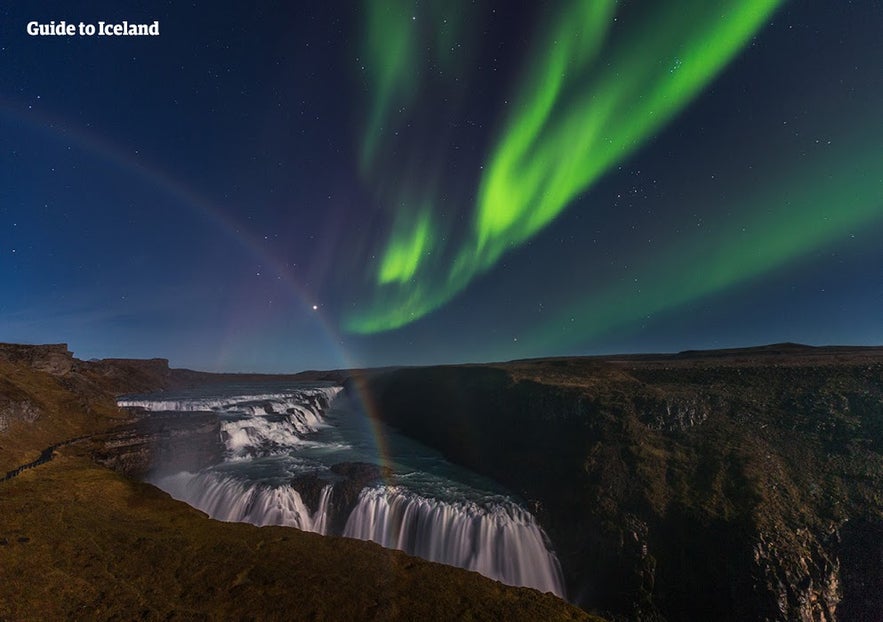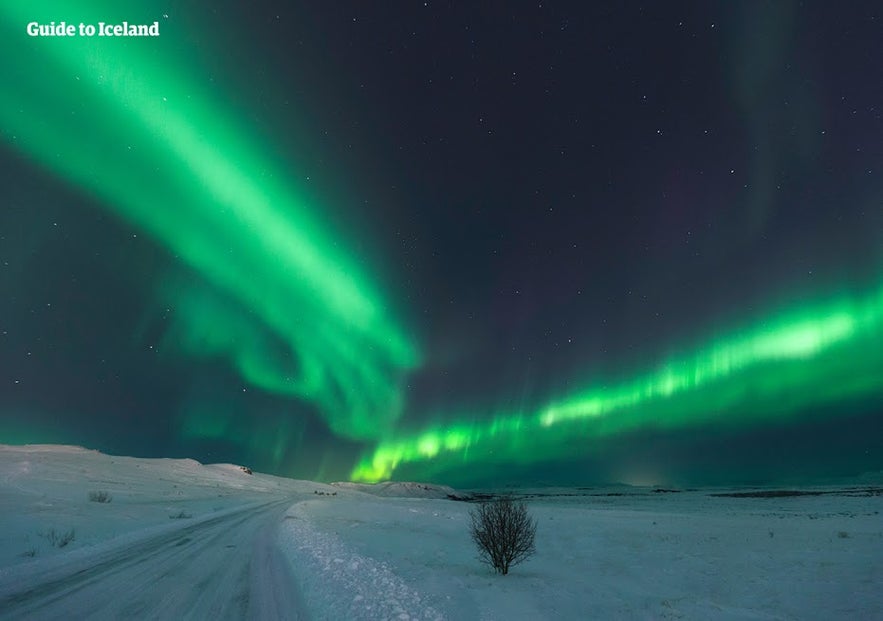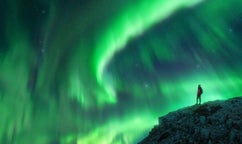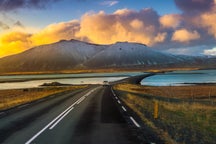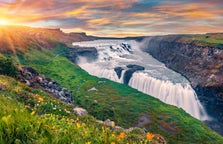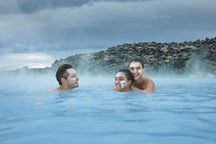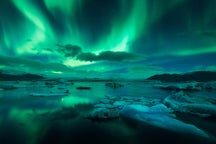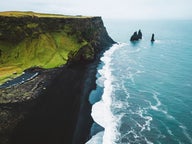I'm going to dispel some myths around the Northern Lights, and give you some VERY SIMPLE and VERY EFFECTIVE tips on how to see the Northern Lights, when to see the Northern Lights and where to see the Northern Lights. Expect all the dumb, and maybe not so dumb, questions out there to be answered.
Can I see the Northern Lights tonight? Can I see the Northern Lights in June? The Northern Lights are not that strong! Are the Northern Lights really that green? It's not possible to see the Northern Lights over Reykjavík. Exactly where, and what time should I be to see the Northern Lights with bright colours? I'm coming to Iceland for Christmas, can I see them on Christmas Day?
My friend's cousin's brother went to Iceland and didn't see the lights, and said the green colour only comes from the camera that picks up more light than your naked eye. This is a photoshopped photo, the lights were not this colour when I saw them! This is digitally enhanced and false advertising!
These are all common questions, statements or complaints, about the Northern Lights in Iceland (or Northern Lights in general, since they are not only seen in Iceland). Whenever a video, or a photo, of the Northern Lights is posted on Guide to Iceland's facebook page, hundreds of comments like this pour in (if you don't believe me, just check the comments on the above video).
So with this blog post I want to explain the Northern Lights in as basic terms as possible.
When to See the Northern Lights?
You can ONLY see the Northern Lights when it is dark outside, or if they are super strong, then maybe you can see them when it is getting dark but already dusk.
Since it DOES NOT GET DARK AT ALL during the summertime in Iceland, from early May until late August, then there is NO CHANCE to see the Northern Lights in Iceland in most of May, all of June, all of July and most of August.
- See also: Midnight Sun in Iceland
There is not a set date when they start and when they finish. I say 'beginning of May' because no-one knows exactly what date it stops being dark enough to be able to see them. On the 1st of May the sun sets around 22:00 and rises around 05:00 but at the end of May the sun sets around 23:30 and rises around 03:30. That doesn't mean that it is dark between 23:30 and 03:30, but more like twilight most of the time, and therefore not dark enough to see the Northern Lights. If you want a set date, then I'd say it's perhaps possible to see the Northern lights until maybe the 10th of May, and from the 20th of August. (This winter I saw them first on the 18th of August, I remember it because it was the day before Culture Night - and last year I was actively looking for them because my in-laws were visiting and we saw them on the 30th of August).
So, in short, the best time to see the Northern Lights is between approximately the 20th of August until approximately the 10th of May - at nighttime when it is dark. No particular hour is better than another, on the shortest days in December or January they might come on at around five in the afternoon, or ten o'clock in the morning (or anytime in between). On longer days, when it gets dark later in the day, they might come on at 18, 19, 20, 21, 22, 23, midnight, 01, 02, 03, 04, 05, 06, 07, 08 or 09 (or in between, they don't show up on the hour!)
And while we're at it, no, it is not dark all the time in winter in Iceland, the shortest day has daylight from around 11:00 to 16:00 (on the 21st of December).
So if you went to bed at midnight and it was cloudy and nothing happening, but the next day someone said they saw the lights just after midnight - they're probably not lying, the weather just changed and you just missed them. So sometimes it's worth it to stay up late to watch the skies - but you're also going to need your sleep!
Note - you will not see them if it is cloudy, or if they are simply not there.
Where to See the Northern Lights?
The Northern Lights appear in the Northern Hemisphere. That means that you can see them in Iceland, Norway, Sweden, Finland, Russia, US state of Alaska, Canada and in Greenland.
In Iceland, you can see them ANYWHERE.
They can BEST be seen if there is no light pollution around, which is why many people choose to drive out of the city lights to admire them better. That does not mean that it is NECESSARY to drive out of town to see them, as you can often see them very clearly from Reykjavík, even right downtown.
You DO NOT NEED TO BOOK A TOUR to see the Northern Lights. If you want to get out of town away from the city lights, but don't have a car to drive yourself, or don't have a driver's license (or you want to sip on a beer while watching them), then it can be convenient to go on a Northern Lights tour. Some Northern Lights tours are also pretty fun even if you see no lights (like a boat ride where you get a view of Reykjavík from afar for example) - but going on a Northern Lights tour is neither necessary, or a guarantee that you will see the lights.
The best chance you will get to see them is if you book a Northern Lights Holiday - that is, you come to Iceland for multiple days, go into the countryside, perhaps drive a rental car and have time at night to look up in the sky in the hopes of seeing them. That way you also get to see some of Iceland's best sights, and seeing the Northern Lights is just a bonus.
The longer you spend in Iceland, the more likely it is you will see the Northern Lights. If you only come for 2 or 3 days, you'd have to be very lucky with the weather. If you come for a week, or 2 weeks, then it's pretty likely you'll see them. If you come for a month, it's almost guaranteed that you'll see them.
How to See the Northern Lights?
My number one tip, and I can not stress this enough: LOOK UP IN THE SKY!
I can not count the number of times I have been walking downtown Reykjavík and have seen impressive Northern Lights in the sky, and then I walk past a group of tourists that are so engrossed in their beer or their phones, or staring down at the pavement to make sure they don't fall on ice or something (which is pretty understandable) that they don't notice anything. I normally point this out to them, but not everyone will.
Just last week there were particularly good Northern Lights over Reykjavík, and I asked a very loud group of tourists (they were talking about their pizza slices) if they had seen the Northern Lights yet (just to check). And the response was "No, but we'd reaaaaally like to!"
So I pointed to the sky.
This happens almost everytime I see the lights in downtown Reykjavík. So don't be the person that went to Iceland and didn't see the Northern Lights because you forgot to look up in the sky and you were too busy complaining on social media how there were no Northern Lights about.
The Northern Lights are a natural phenomenon, they don't start at a certain time and finish at a certain time. They can appear out of nowhere, and leave out of nowhere. They can last for a few seconds, or for a few hours.
JUST. KEEP. LOOKING. UP. IN. THE. SKY.
AND. REPEAT.
The Northern Lights are Not That Strong, Only Cameras Pick Up the Green Colour!
FALSE.
Maybe you didn't see very green colour when you saw them. Or maybe you didn't see the Northern Lights dance in the sky. Or maybe you know someone, that knows someone, that didn't think the Northern Lights were that impressive, and they told you that you have to have a good camera to see the colours.
That's not true.
What is true is that if you have a good camera, and use a long aperture and the right ISO setting, then you can capture light on the camera that the naked eye does not see - so images can enhance the colour of the Northern Lights. BUT, it's also very, very, VERY possible to see very strong colours of green, pink, purple, white and red with your bare eyes.
I've seen them many times.
Also, the photographs you see are mostly shot when there is a particularly good Northern Lights display, because, of course, the photographers want to get the best shot possible. That also means that there are many nights when they didn't take pictures of the lights because they were too faint and not as impressive. Although the Northern Lights appear very often, exceptionally strong Northern Lights are not as frequent. (Still, you can maybe catch amazing Northern Lights on average once or twice a month - sometimes there's an amazing show a few days in a row... there's really no order to it).
Here's another thing I can't stress enough: The Northern Lights are a NATURAL PHENOMENON.
That means that they vary in strength, and style, and pattern, and intensity, and colour. Sometimes even from second to second. They can be not that strong one second and then they start picking up and a minute later the whole sky is ablaze with colour. Mostly green (the most common colour), but also sometimes pink, red or purple. Then a minute later - or a few hours later, depending on your luck - it's all gone.
Think about some other natural phenomenon. Like rain. Imagine that you had never in your life experienced rain and really wanted to. Then you travel to England, because they are famous for having a lot of rain. You go to London for 3 days. BUT, it's sunny the whole time! Does that mean that they never get any rain? No, it just means you were unlucky (or lucky, really).
On the last day, there's a little bit of a drizzle. Not really even a drizzle, just a fog that's kind of wet. A mist. If that's your only experience of rain, will you then assume that that's the only type of rain there exists?
Similarly, the Northern Lights can be very faint, to the point where you're not really sure if you're looking at a cloud with a slight hint of colour in it, or watching the Northern Lights. They can move slowly, almost imperceptibly slowly, or they can dance with fury in all directions. The difference is as great as between a mist, and monsoon season.
Perhaps the Northern Lights should have as many names as rain does depending on how active they are - mist, drizzle, sprinkle, flood, shower, monsoon, sleet, hail, thunderstorm, raining cats and dogs, raining buckets...
As a result, they can not be accurately predicted (there is an aurora forecast that you can look up, but it's as dependable as the weather forecast, as in, not really that dependable at all).
And yes, some pictures are enhanced or photoshopped to make them look more amazing - but a strong Northern Lights display will still take your breath away.
So don't ask if there will be Northern Lights during your trip months, weeks or days in advance, as no-one will be able to tell you. If they do appear, then it's an added bonus to your trip, since Iceland has so many other natural attractions that make it worth visiting :)
- For more general information about the Northern Lights, see also: Northern Lights in Iceland
FYI - I can't count the number of times I've seen the Northern Lights - but I've also missed many sightings as they often take place while people are asleep - can you count the times you've experienced rain or snow?


